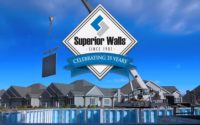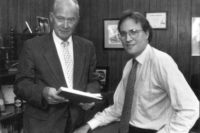Sto Corp celebrates its 35th year in the U.S. According to Sto’s President of the Americas, Dave Boivin, now in his 11th year at Sto, the company was formed in the U.S. in 1979 to sell insulated wall systems to the U.S. market. It began as a New York sales company and management quickly realized that they could not import products from Germany and be successful in the U.S. To compete in this market, Sto’s first U.S. plant opened in Rutland, Vt. The area was chosen because it was centrally located to large population centers of Canada and the U.S. in a 500 mile radius.
The company was first called Sto Energy Conversation Company, as high energy costs after many years of oil embargos erratic supply were making Americans very conscious of their energy consumption. “Later, as the pressure on energy prices subsided, architects seemed to migrate to the advantages of the insulated wall systems in regards to aesthetics and design flexibility,” said Boivin. “Sto products were highly regarded from the beginning for their quality and the excellence of the German product engineering. Sto provided innovative solutions for large ornamental type projects, such as casinos, hotels and theaters, which showed integral architectural detail. Architects and owners quickly saw our systems as a cost effective alternative that was aesthetically pleasing.”
Sto’s business grew rapidly, and they discovered a larger, growing market in the Southeast. The company built a second manufacturing plant in Atlanta in 1989. The EIFS and stucco business continued to grow rapidly, despite challenges from the brick industry and others around durability and flammability through the 1980s and early-90s attempting to slow down the growth. The major manufacturers came together, including Sto, to meet the challenges and conducted extensive fire testing to very stringent NFPA285 fire standards and developed new solutions to address durability concerns.
In the late 1990s, another industry challenge arose with a class action suit, with claims that systems were entrapping moisture. The industry spent time from 1997 to 2003 meeting challenges from the plaintiffs’ bar and validating that the systems would work properly with proper installation. According to Boivin, the industry had to make this fail proof. They created air and moisture barriers and drainage planes to act as a “belt and suspenders approach” which have made the current systems to be regarded as the “perfect wall system” in the words of many in the building science community.
“Four to five years were spent dealing with these issues and the survival of the industry was threatened,” said Boivin. “When I came to Sto in 2003 I felt we needed to change the mentality. Litigation was winding down and manageable, so we pivoted to growth and profitability.”
At this time there was a strong construction market (late 1990s to 2008). Sto grew rapidly via strengthening our distribution network and improving our market share position and diversifying into new products in the four core product lines Sto has today, according to Boivin.
“During the recession of 2008 - 2011 there were opportunities to grow geographically, and Latin America was ideal,” said Boivin. “Sto made two major acquisitions—in Chile and Brazil—and tapped into economically and politically stable markets. We are making a major commitment to enhance our positions in Canada and the US as well, since we see a robust recovery in these construction markets. Sto is positioned to grow throughout the Americas, and we expect the company to double in size over the next five years.”
Sto Corp. developed and continues to grow four core product lines:
- StoTherm ci – Sto’s EIFS product. New building codes require continuous insulation. The impact is felt very strongly in insulated wall systems themselves for both commercial and residential. Sto is in an ideal position to take advantage of the new codes because EIFS is the simplest way to comply with the new CI requirements.
- StoGuard – A fluid applied air and moisture barrier, and an important component of StoTherm ci systems. StoGuard bonds with the substrate to give structural integrity to the wall. It has a dual benefit – air (for tightness) and moisture (for protection). A liquid barrier lasts the life of the substrate.
- StoPowerwall – Sto’s stucco product for light commercial and residential construction. Sto has a broad range of products under and on top of stucco, and Boivin expects it will be a big market for the next five to six years.
- Specialty Architectural Coatings – StoCoat Lotusan with Lotus-effect technology, an exterior coating with a pronounced cleaning effect, is Sto’s flagship product. According to Boivin, Sto has embarked on a major effort to establish restoration of existing buildings. “One-third of our sales come from restoration,” said Boivin. “The market never goes away – the relationships and products are needed. We’ll become a force in the restoration arena. We have an array of products to help in restoring buildings and we will grow our line substantially over the next five to six years.”
“Latin America continues to offer us opportunities, and we will be selective where we expand,” said Boivin. “Markets attractive to us are Chile and Brazil, as well as Peru, Colombia, Costa Rica, Panama, and the Caribbean. Over time others may offer opportunity, as there is unlimited potential for Sto in this market.”
Sto Corp. has had a presence in Canada for 26 years, and the company continues to see growth there. According to Boivin, the company sees lots of potential, especially in the Prairie states -- in British Columbia and the eastern half of the country, where the company hasn’t been as strong in the past.
“Sto Corp. has built a foundation around insulated walls and stucco in the Americas, and we’ll continue to look for opportunities to bring German products here, which takes time and money,” said Boivin. “We’ll evaluate each of them when they become available. We are also ideally positioned to acquire other companies. So far, we’ve grown mostly organically and selectively, and we look forward to continued growth and success over the next 35 years.”





Report Abusive Comment